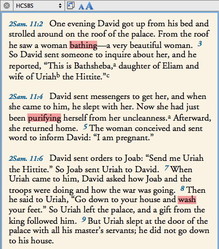Yesterday I described how you can use Accordance’s highlighting feature to mark key words in a passage. Using different highlight colors for different key words enables you to see clearly which words and concepts are oft-repeated, which in turn can help you identify important themes or motifs. Today I want to show you how this works by looking at a specific example: the story of David and Bathsheba in 2 Samuel 11.
 Everyone knows this story begins with a bath, so let’s start by going through this passage and highlighting every mention of bathing or cleansing. Here’s what you should end up with:
Everyone knows this story begins with a bath, so let’s start by going through this passage and highlighting every mention of bathing or cleansing. Here’s what you should end up with:
If we examine these three mentions of bathing, we notice several important aspects of the narrative. First, Bathsheba’s act of bathing leads quickly to the act of adultery. Yet it is described without any moral judgment on the part of the narrator. There is no indication that Bathsheba was intentionally trying to be seen or that David made a habit of rooftop voyeurism. At this point, only the essential facts are given: Bathsheba was bathing and David saw her.
Second, the explanation that her bathing was an act of purification from menstrual uncleanness introduces an element of irony and foreshadows the trouble to come. The irony is that an act of cleansing from menstrual impurity led to the far greater defilement of marital infidelity. (There’s even an easy double alliteration for you preachers!) The foreshadowing comes from the fact that the end of the period of purification would have been the time when Bathsheba was most likely to conceive. For all his calculated scheming, David failed to take that into account until it was too late.
Finally, David attempts to cover his sin by sending Uriah home with the encouragement to “wash his feet”—a euphemism for enjoying all the comforts of home. Yet Uriah refuses to “wash,” and thereby manages to be the only person in this story who remains clean. (If you’re looking for more double alliteration for your sermon, I personally think maddening integrity works well.)
As you can see, I’ve just highlighted three words which develop a theme of cleansing, and already I’ve got the basic outline of a sermon! What’s more, it’s a sermon which derives its points directly from the text and which lends itself to a variety of applications.
Obviously, not every motif in every passage will lend itself so easily to serving as the foundation of a sermon, but I hope you can see how powerful these simple observations derived from the simple act of highlighting really can be.
Now you try it. Highlight all the times the word “house” is mentioned in this passage. Then ask yourself how each occurrence of that key word helps to develop a theme. What is that theme and how does it give you insight into the narrative as a whole? You’re welcome to share your observations in the comments if you’d like.
Tomorrow we’ll look at another oft-repeated word in 2 Samuel 11, and I’ll use that to show you an easy way to highlight every occurrence of a word in a given passage.

